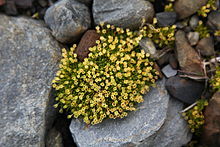Colobanthus quitensis
| Colobanthus quitensis | |
|---|---|

| |
| Antarctic Pearlwort at St. Andrews Bay, South Georgia | |
| Scientific classification | |
| Kingdom: | |
| (unranked): | |
| (unranked): | |
| (unranked): | |
| Order: | |
| Family: | |
| Genus: | |
| Species: | C. quitensis
|
| Binomial name | |
| Colobanthus quitensis | |
| Synonyms | |
|
C. alatus, C. aretioides, C. billardieri, C. cherlerioides, C. crassifolius, C. crassifolius var. aretioides, C. maclovianus, C. meingeni, C. quitensis var. alatus, C. saginoides, Sagina crassifolia, S. quitensis, Spergula affinis? | |
Colobanthus quitensis (Antarctic pearlwort) is one of two native flowering plants found in the Antarctic region.[1] It has yellow flowers and grows about 5 cm (two inches) tall, with a cushion-like growth habit that gives it a moss-like appearance.
Within Antarctica, due to climate change, more seeds are germinating, creating a large number of seedlings and plants. Reports indicate a fivefold increase in these plants, which have extended their ranges southward and cover more extensive areas, wherever found. Deschampsia antarctica (Antarctic hairgrass) is the only other native flowering plant in the region.[2]
Synonyms include Sagina quitensis.
Distribution
It is found on the west coast of the Antarctic Peninsula, on South Georgia, South Shetland and the Falklands, and in the Andes, becoming increasingly rare northwards, but reaching Bolivia, Peru and Ecuador, with a further isolated population in Mexico.[3]
References
- ^ Kozeretska, Iryna (2005), THE HERBARIUM OF ANTARCTIC VASCULAR PLANTS, National Taras Shevchenko University of Kyiv, retrieved 9 February 2015
- ^ Rudolph, E. D. (Apr 1965), "Antarctic Lichens and Vascular Plants: Their Significance", BioScience, 15 (4), American Institute of Biological Sciences: 285–287, doi:10.2307/1293425, JSTOR 1293425
- ^ Colobanthus quitensis at botany.cz
